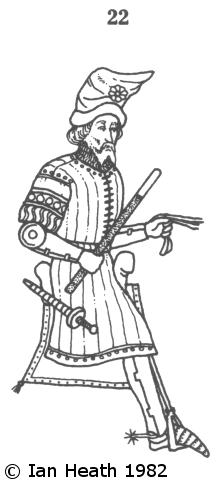
Find the perfect fit with Amazon Prime. Try Before You Buy.
COMMANDER OF COMPANIONS, SIR ROBERT KNOLLYS
An extract from Armies of the Middle Ages, Volume 1by Ian Heath



22. COMMANDER OF COMPANIONS, SIR ROBERT KNOLLYS
From an illumination in the ‘Grandes Chroniques de France’ of c. 1398, the original caption to which reads ‘Robert Canole and Messire Thomas de Garanson and their English company . . . to the number of 600 men’, this figure represents Sir Robert Knollys, described by Froissart as ‘the most able and skilful man-at-arms in all the companies.’ Born in 1320, he fought at Crécy, the Combat of the Thirty and Mauron, then for Charles the Bad of Navarre and later under Chandos at the Battle of Nájera, as well as being involved in the chevauchées of 1356, 1359-60, 1370 and 1380. He was one of the principal leaders among those who rallied to King Richard II’s support against Wat Tyler in 1381, and he died in 1407. He had once boasted that he fought neither for the king of England nor the king of France but for himself, and indeed many of his contemporaries called him ‘the old brigand’.
Knollys is depicted in dress typical of that worn on the march or in camp by noblemen and commanders, as witnessed by many mss. of the second half of the 14th century. His arms and legs are protected by full plate harness, but otherwise he wears only a dark blue quilted aketon with gold-embroidered short sleeves. The upright mail collar, called a standard, is undoubtedly part of an arming doublet worn under the aketon, such doublets being illustrated or recorded in many 14th-15th century sources. They comprised a quilted bodice onto which pieces of mail were sewn, these usually comprising the standard, gussets (or voiders) at armpits and elbow joints, or sometimes complete mail sleeves, and a short mail skirt. It was worn under the plate armour in place of the gambeson and old mail haubergeon. It can therefore be seen that Knollys needs only to discard his ‘travelling aketon’ and replace it with plate harness, jupon and helmet to be ready for battle. Some pictures even show men thus equipped in battle-scenes. His hat is red with a gold brooch, his belt is gilt, and his dagger-sheath is blue.
Note also his marshal’s baton, called a bastoni di comando in Italy. As a symbol of office the baton seems to have succeeded the mace, from which it undoubtedly evolved - some captains indeed retained maces, or even war-hammers, or had batons with mace-like characteristics, usually a gilt spherical head. They were generally some 30" long, though sometimes only about half that length, and usually had a brass or gold tip. The ‘white rod’ which Froissart records Edward III carrying when he addressed his troops before Crécy was probably such a baton.